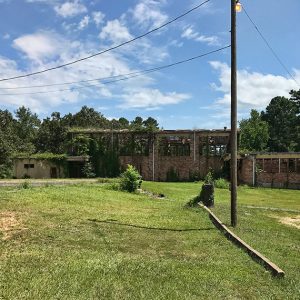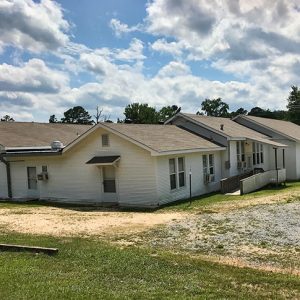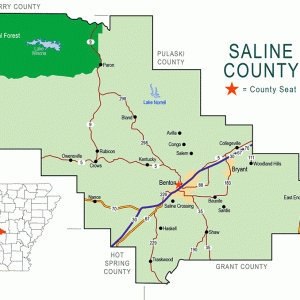calsfoundation@cals.org
Gravel Hill (Saline County)
aka: Ralph Bunche Community (Saline County)
aka: Southside (Saline County)
aka: Jack Rhinehart Community (Saline County)
aka: Hardscramble (Saline County)
The community first called Gravel Hill is one of the oldest historically African-American neighborhoods in Saline County. Its roots were planted when the Rhinehart and Canady families from Bauxite (Saline County) moved there in 1894. Gravel Hill later changed its name to Southside Community, and then, in 2002, the community was renamed again, this time in honor of Ralph J. Bunche, the first African American to be awarded the Nobel Peace Prize. The community’s boundaries include Willow Street on the north, Hillside Drive on the south, Neeley Street on the east, and Market Street on the west. Additions that make-up the community include the Cloud, D. S. Moore, Gingles, Gravel Hill, Houston, South Hill, Stewart Heights, and Wilkerson. Notable residents include W. A. Ashley and Elect Temple Elder Willie Barnes Jr., brother of Bruce “Sunpie” Barnes. In 1981, Charles F. Cunningham Sr., a resident of the community, was elected by the Benton City Council as Benton (Saline County)’s first African-American mayor. He served as mayor for two years.
Saline County’s first African-American residents were members of both free and enslaved families. In 1838, there were 416 slaves and two free blacks living in Saline County. By 1860, there were 749 slaves. In 1870, there were only fifty-seven African Americans living in Saline Township, which contains Benton. Ten years later, in 1880, there were 142, with names like Rhinehart, Canady, and Tyson. In 1894, the Rhinehart family purchased land on the western end of what is now Palm Street in Benton. They settled there, and the Gravel Hill Community was established soon after.
Burl Rhinehart married Lola Canady and they had seven children—four boys and three girls. Their home was located at the western end of Palm Street. Later, a portion of their land was sold to a railroad company. W. A. “Wes” Ashley purchased land from former Benton mayor David Madison Cloud in 1904. The Cloud Addition was bounded by Oak, Pine, Dixie, West, Valley, and South streets. In 1907, the W. A. Ashley House was built. It is one of the community’s oldest homes. In 1919, Annie Little Johnson moved to the community from Okolona (Clark County) to be with her brother, who was working in the bauxite mines. Johnson later served as a maid for the family of Robert Ashby for fifty years.
At the time, there was no indoor plumbing in the neighborhood. Johnson assembled a committee at the request of Mayor Henry Finkbeiner to raise funds so that the city could run new pipe to the community and connect it to the main line. Benton’s lumber, furniture, and barrel-making mills provided employment for black men, while women worked as maids or cooks in the homes of white families. Servants lived in servants’ quarters located behind their employers’ homes. The J. J. Ball Gravel Company also employed many residents.
Most of the community’s oldest families came from the nearby company town of Bauxite. There, African Americans lived in company housing in two separate areas that combined to form what was called Africa Camp. By December 1920, fifty-three families and 140 single men lived in Bauxite’s Africa Camp. Families lived in homes that housed two families each, while the single men lived in one large bunk house and two smaller buildings. Bauxite’s Woodland Housing Project was created specifically for black residents. In 1932, most of Bauxite’s Mexican residents were removed to Laredo, Texas. After the country entered World War II, Africa Camp was overcrowded, so houses in Mexico Camp were opened to black residents. Woodland Elementary School provided an education for their children until the Woodland Project and Mexico Camp were closed in 1953 after the Korean War ended. With Bauxite’s economy in decline, many fled to neighboring Benton and Bryant (Saline County), while those who came from Little Rock (Pulaski County) to work stopped coming to the area.
Gravel Hill became home to several churches. Pleasant Hill African Methodist Episcopal Church was founded in 1897 by the community’s first families. The original building was located on Palm Street but was moved to 302 Reed Street and was dedicated on August 25, 1901. St. Paul Missionary Baptist was founded soon after Pleasant Hill. Its current building was dedicated on September 25, 1909. In 1928, Bishop G. G. Greer and Elder D. L. Sanders founded the Elect Temple Church of God in Christ. The current Elect Temple building was dedicated in 2004. Mount Zion Missionary Baptist was founded in 1933 in Bauxite but relocated to Benton in 1953. Mount Zion was rededicated on June 2, 1985, and rebuilt in 1991. Johnson Street Church of Christ was founded in 1954 with help from members of Benton’s Northside Church of Christ. Woodlawn Cemetery lies just behind the multipurpose building.
Before there were schools in the area, students met for class in local churches and in the old Independent Order of Oddfellows (IOOF) Hall on the corner of Reed and Dixie streets. Gravel Hill School was built using government funds in 1910. In 1926, the land it stood on was sold, so the school closed. In 1947, the Ralph Bunche School was built for elementary students. Ralph Bunche High School was dedicated in 1959. The Ralph Bunche School multipurpose building was built in 1961–62 academic year. Benton began integration in 1965 at what is now Angie Grant Elementary on Hoover Street. In 1966, Benton High School graduated its first African-American students, and by 1968, integration was complete. In 1969, the Central Arkansas Development Council (CADC) converted the old Ralph Bunche elementary into a Head Start Pre-School and Kindergarten. The multipurpose building was left abandoned until the Men’s Alliance of Saline County purchased it and the remaining school buildings at an auction from the City of Benton in 1976 for $8,001.50.
On September 23, 1996, the Benton City Council discussed the permanent closing of Neely Street’s railroad crossing, which connected the community to Edison Avenue. The following day, the Benton Courier reported that Bill Ryan of the State Highway Department recommended the closing of Neely Street because of three accidents there that led to four deaths. Thus, the street was closed off to automobile traffic from then on. Later, a bridge was built over the tracks at the intersection of 2nd Street and Edison Avenue.
On January 17, 2002, the Benton Courier reported that the community would be renamed in honor of African-American Nobel Peace Prize recipient Ralph Bunche, who worked to resolve the Arab-Israeli conflict in the 1940s. A park in the community also bears his name. In 2003, former mayor and CADC director Charles F. Cunningham was elected alderman for Benton’s second ward, in which the community resides. The Ralph Bunche Neighborhood Association was organized on July 9, 2011. The group’s mission is to “preserve, protect, and enhance the quality of life in the Ralph Bunche neighborhood.”
On April 18, 2017, Charles F. Cunningham passed away at his home. He was laid to rest in Woodlawn Cemetery. Later, a pavilion at Ralph Bunche Park was named in his honor. On Sunday, October 29, 2017, the Saline Courier announced that the Central Arkansas Development Council and the Men’s Alliance of Saline County had applied for a $494,750 grant from the National Park Service to rehabilitate the multipurpose building for use as an event center with an archive to help “document the civil rights experience of students and educators who came through the Ralph Bunche school.” On Sunday, February 18, 2018, the Saline Courier reported that Benton’s first African-American graduates were being honored as part of Black History Month. Those honored were Lois Gooding, Charlene Dawn, Amel Heard, Florence Allen, Mary Franklin, and the late Andrew Cox, all residents of the Ralph Bunche Community.
For additional information:
Barnes, Cheiron. “A History of the Black Community of Benton.” The Saline 27 (Fall 2012): 21–23.
“Charles F. Cunningham (1933–2017).” Saline Courier. April 21, 2017.
“Dedication of Negro School Set.” Arkansas Democrat, October 23, 1959, p. 20.
Hollenbeck, Lynda. “Southside Now Bunche.” Benton Courier, January 17, 2002, p. 1.
Morrison, Elisha. “Men’s Council, CADC Look to Rehab Ralph Bunche Gym.” Saline Courier, October 29, 2017, pp. 1, 5.
Morrison, Elisha. “First and Foremost: Benton District Honors First Black Graduates.” Saline Courier, February 18, 2018. p. 1B.
Perdue, Steve. “Pictorial History of the Ralph Bunche Community.” 2009. David O. Demuth Arkansas Collection. Bob Herzfeld Memorial Library, Benton, Arkansas.
Cody Lynn Berry
Benton, Arkansas
 Bunche School Gym
Bunche School Gym  Ralph Bunche Elementary School
Ralph Bunche Elementary School  Saline County Map
Saline County Map 




Comments
No comments on this entry yet.